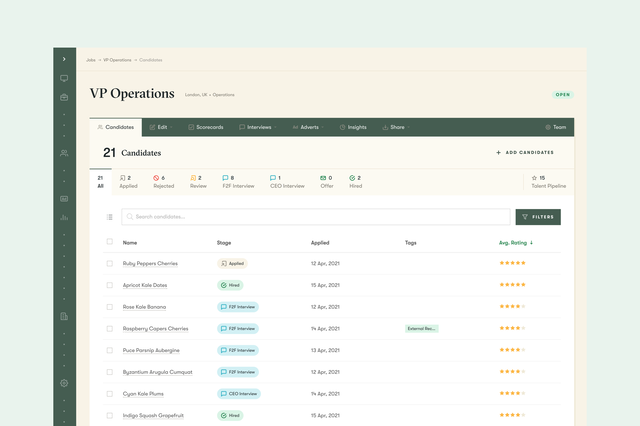
Blind Recruitment: How Anonymous Hiring Improves Diversity
What is blind recruitment?
Blind or ‘anonymous’ recruitment is the process of removing the candidate’s name and any other identifying factors from resumes, applications, and assessments during the recruitment process. This can include information like their:
- name
- contact information
- age
- gender
- race
- photo
Blind recruitment helps hiring teams to assess applicants exclusively on their suitability for the position and reduces the risk of conscious and unconscious bias.
The result? Fairer representation at the interview stage, and better hiring outcomes.
Anonymous resumes and applications are the foundation of a blind hiring process. Modern applicant tracking systems like Pinpoint have the ability to anonymize resumes and applications with a single click.
What does a blind resume look like?
Blind resumes (sometimes called redacted resumes or anonymous resumes) can be presented in a number of ways.
At the most basic, recruiters can manually redact the information using pen and paper or image editing software. But this is a time-consuming process.
Increasingly talent teams are turning to modern recruitment software that includes resume anonymization tools. The software parses the contents of applications and resumes, presents the information in a standardized format for every candidate, and redacts information that could result in conscious or unconscious bias.
By presenting every application and resume in a standard format, it’s easy to compare candidates side-by-side.
Pros and cons of blind hiring in recruitment
Blind hiring is a powerful tool for reducing the risk of bias in the recruitment process and ensuring that hiring teams are focused on finding the best candidate for the job.
But anonymous recruiting is only one part of a diversity recruitment strategy.
Anonymous recruiting CAN help improve the diversity of the candidates that get past an initial screen (assuming you’re attracting those candidates in the first place).
Anonymous recruiting CAN’T eliminate bias during interviews, it doesn’t ensure your new hires feel welcomed on their first day, and it doesn’t ensure they can progress through the organization and be an example for future candidates.
Watch the whole interview with Esther: How to Double Down on Diversity With the Power of Internships
Blind hiring can’t solve your diversity problems on its own
Organizations run into trouble when they assume blind hiring will be a fix-all for their diversity problems.
You need to attract a diverse talent pool
Where you advertise and the content of your ads, how you talk about diversity, and the opportunities you offer for progression will all affect whether you attract a diverse pool of candidates in the first place.
You need an interview process that’s fair
Once candidates arrive for interview, conscious and unconscious bias can still creep in. That’s why we recommend using prescriptive questions, and interview scorecards to ensure your process is as fair and objective as possible.
Blind hiring can introduce new risks
But if you know about them, you can head them off.
Risk 1: Lack of context
A two-year gap in employment might seem like a red flag, but could be a very reasonable period to take off for somebody recovering from serious illness.
Risk 2: Quotas and Affirmative Action
If you have specific quotas around diversity, or use affirmative action to help improve diversity, blind hiring won’t be possible at every stage of the process—you can’t ensure an even gender split at the interview stage if you don’t know the gender of the candidates.
But despite there being well-publicized examples of blind recruitment trials that backfired, blind hiring can still help—even when trying to meet diversity quotas. It just needs to be applied in the right way.
For example, if an organization is using affirmative action, the recruitment team could put forward equal-split shortlists to hiring managers with blind hiring enabled for the hiring managers when reviewing the shortlist.
Risk 3: Complacency
Don’t assume that by enabling blind hiring you’ve done enough.
If you’re manually redacting applications and resumes at least one person is going to see the unredacted versions. Equally, blind recruiting doesn’t automatically result in a more diverse range of applicants, a fairer interview process, or ensure your new hires feel welcome and can progress in your organization.
That’s why training and awareness around conscious and unconscious bias is still critical.
Hiring Bias: Why personal characteristics affect hiring decisions
You’d assume that with the right training, the right team, and the right intentions the risk of bias in hiring is low. But you’d be wrong. And there’s good reason for that.
Hiring managers are often time-poor, have hundreds of candidates to sift through, and have to make a lot of choices about who to progress to the next stage in a very short period of time.
In times like this when we’re overloaded, time-poor, or have lots of choices to make, we naturally fall back on our System 1 brain. This is the mode that results in fast, unconscious decision making based on emotion, instinct, learned associations, and impressions we’ve created of the world around us.
But when we’re deciding who to hire, we should be using our System 2 brain—the mind’s slower, analytical mode where logic and reason dominate, enabling us to assess candidates on merit.
The purpose of blind hiring is to reduce the risk of bias in the selection proves by limiting access to information that could inadvertently influence a decision.
This can include:
Applicant’s name and photo
As part of a study, researchers sent out almost 13,000 fake CVs to over 3,000 job postings. They found that people with Chinese, Pakistani or Indian-sounding names were 28% less likely to get invited to an interview than the fictional candidates with English-sounding names (despite their qualifications being the same).
A candidate’s name is also a clear indicator of gender, which in some cases can play a part in bias, and the removal of a name minimizes the chance of gender-based discrimination.
Address and contact information
The home address of a candidate can reveal information about their socio-economic background that could cause unconscious bias.
If the backgrounds of candidates don’t match those of current employees, an employer may be unconsciously inclined to rank the candidate lower due to the possibility of them not working well with current employees. Therefore, the removal of the candidate’s home address can be a valuable alteration.
Age
Removing the date from applications and CVs is an obvious step if you’re trying to reduce age discrimination. But years spent at previous jobs and periods of education will allow the age of a candidate to be roughly estimated. Removing these dates from the information presented to your team members that are part of the selection process will help to reduce the risk of age bias.
Gender
This one is pretty obvious, removing gender from the resume means gender is no longer something to judge the applicant on.
Race
Removing the race of an applicant means that no bias can be applied to the candidate during this part of the recruitment process.
Education
The names of schools always attract an assumption regarding the academic caliber of students. However, the University a candidate graduated from has little relevance to their suitability for a certain job.
Also, the University a candidate attended can indicate their ethnicity or economic background resulting in a higher risk for bias.
Even if you, as the employer, don’t perceive them to be less-skilled, you might be deciding they’re less suitable unconsciously based on your preconceived notions of different schools.
But a word of warning
When we first launched our own blind recruiting feature, removing information about education history and previous employers drove the wrong behaviour—hiring managers felt they had too little information to make an informed decision and started trying to find the candidate online by copy-pasting chunks of their CV into Google.
So while the theory would say that you need to remove as many details as possible, real-world blind hiring processes often don’t, and with good reason.
Blind Recruiting Statistics: Does blind recruiting really work?
What’s the problem we’re trying to solve
Bias during the recruitment process results in a less diverse organization and worse hiring outcomes.
- Candidates with Muslim-sounding names are three times more likely to be passed over for jobs.
- In this study, nearly twice as many applications with Indian-sounding names had to be sent for the same level of successful outcomes as for applications with White-sounding names.
- In this study, ethnic minority applicants were discriminated against in favour of white applicants in 29% of cases.
- This study showed that equivalent resumes with Black-sounding names are 50% less likely to receive a callback for an interview than those with White-sounding names.
- In this study, a candidate with a Turkish-sounding name that wore a headscarf had to send 4.5 times as many applications as an identical applicant with a German-sounding name and no headscarf to receive the same number of callbacks for interview.
- Research from PwC shows that 1 in 5 women experience gender discrimination in recruitment.
So we have a problem.
Why should we care?
Unless you’ve been living under a rock, you’ll know that the business case for diversity is strong. Studies show that the relationship between diversity on executive teams and the likelihood of financial outperformance has strengthened over time.
In fact, companies with more than 30 percent women executives were more likely to outperform companies where this percentage ranged from 10 to 30.
But progress on diversity is slow. This McKinsey study shows that in the United States and the United Kingdom, female representation on executive teams is rising slowly—from 15% in 2014 to 20% in 2019.
If the diversity of your talent pool isn’t represented at the interview stage, blind recruitment can have a big impact.
Is blind recruitment effective?
Studies show that blind hiring works—including examples where as many as 50% more women have got through to the final selection stages when using a blind screen.
One of the earliest blind recruitment trials was this one—orchestras ran blind auditions and found the probability a woman will be advanced out of certain preliminary rounds is increased by 50%, as well as enhancing by “severalfold” the likelihood a female contestant will be the winner in the final round when using blind screening.
Blind recruitment case studies
Companies like Adalo, Everi, and Wagepoint use the blind hiring feature of Pinpoint’s applicant tracking system and consistently see the diversity of the applicant pool better represented at the interview stage as a result.
How to design a blind hiring process
There’s always that little bit of uncertainty with a new process, but everyone has adopted Pinpoint really well. I think that the efficiency and user experience of the system has helped to gain our team’s overall buy-in for the new process.
Through our work with hundreds of companies all over the world that use the blind recruiting feature of our ATS, we’ve learned a lot about what does and doesn’t work when introducing blind hiring into your recruitment process for the first time.
Here’s our advice…
Set the right expectations with the whole organization
Blind hiring is just one part of the diversity puzzle. Make sure that’s clear to everybody.
There are pros and cons to blind hiring and there’s a big difference between how you’d approach the goal of reducing bias in the pre-interview screening process (hint: blind hiring can help here) vs ensuring your run fairer interviews (hint: you should be looking at scorecards rather than blind hiring if this is your biggest problem).
Introduce blind hiring the right way
Some hiring managers will be on board with anonymous hiring immediately. Others might complain that it makes the screening process more difficult.
Most of the organizations we work with roll blind hiring out gradually—starting with roles where they know they have a diverse pool of quality candidates applying, but don’t see that diversity represented at interview.
The last thing you want to do is introduce blind hiring when you don’t have a diverse pool of candidates in the first place as it’ll make no difference and the naysayers will get their way!
Dealing with pushback
It’s not unusual to get pushback from some hiring managers.
That’s why talent acquisition teams that introduce blind screening as part of a program of overall improvements to their recruitment process get the best results.
Hannah Irwin, Senior Human Resources Associate at Pivot Energy explains how this worked for her:
“There’s always that little bit of uncertainty with a new process, but everyone has adopted Pinpoint really well. I think that the efficiency and user experience of the system has helped to gain our team’s overall buy-in for the new process.”
By saving her hiring manager’s time in the recruitment process overall, she was able to get buy-in for blind hiring.
Learn more about how Pivot Energy implemented blind hiring here: Pivot Energy Blind Hiring Case Study
Be careful how much you redact
Deciding what information to redact is an important decision.
Blind recruiting practices like name-blind recruitment (just redacting the candidate’s name) used to be the default approach, and can certainly deliver results. But most recruitment teams use modern blind hiring practices that take a more holistic approach and redact information like age, gender, photos, and contact information.
Some take it a step further, removing information like names of schools and previous employers.
But be careful.
We quickly found that removing names of schools and previous employers drove the wrong behaviour—hiring managers felt they had too little information to make an informed decision and started trying to find the candidate online by copy-pasting chunks of their CV into Google. This defeats the whole point of anonymous hiring.
Over time we’ve found the right balance and, today, Pinpoint’s blind hiring feature removes:
- Name
- Age
- Photo
- Address
- Other contact information
- Link to LinkedIn profile
- Words and phrases that could allude to protected characteristics
Give candidates a replacement name
Rather than just removing names from applications, consider replacing them with something completely random. This makes it easy to identify which candidate people are talking about when reviewing applications as a team.
DON’T use numbers. We began by numbering candidates instead of giving them names, and found that lower-numbered candidates would be invited to interview disproportionately more often than higher-numbered candidates.
DO use random words. We use random combinations of colours, fruits and vegetables in the blind hiring feature of our recruitment software.
Set goals and measure the results
If you want buy-in, you need to monitor how blind recruiting impacts diversity performance. Set benchmarks before you start, and review these over time to determine whether blind hiring is working for you.
A good goal would be to see the diversity of your overall candidate pool for a department reflected in the first stage interview.
Using equality monitoring data from your applicant tracking system before and after introducing blind hiring to report on how representation improves over time.
Blind resume screening
Once you’ve decided what information to remove candidate’s resume’s you’ll need to decide how you’re going to manage the resume anonymization process. You could:
- Manually redact resumes (this is where a lot of teams start out with blind hiring but the prove it works they usually look for a tool to help them automate the process).
- Use dedicated blind recruitment software (this is ideal if you’re using a legacy applicant tracking system that doesn’t have a blind hiring feature).
- Use the blind recruitment software that’s part of your applicant tracking system.
If your applicant tracking system has a blind recruitment feature this is almost certainly the best way to go. There will be no manual work, and you can ensure that nobody (not even your recruitment team) will get to see the unredacted version of the resume until an interview’s scheduled!
Blind application process
As well as anonymizing resumes, you need to anonymize the contents of any application forms, personal summaries, and cover letters.
The easiest way to do this is to make a dedicated application form on your website (that’s integrated with your ATS) the default way to apply to your organization. Modern recruitment software will anonymize the contents of the application form as well as the resume.
For example, when you turn blind hiring on in Pinpoint, answers to all questions on the application form are anonymized automatically—we even take care to remove words in long-form written answers that could allude to protected characteristics.
Get started with Blind Recruitment
Discover how Pinpoint makes it easy for talent acquisition teams to offer a fairer selection process, and improve diversity










